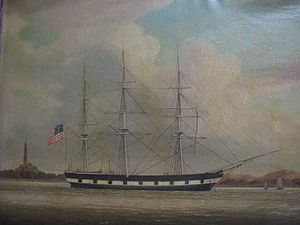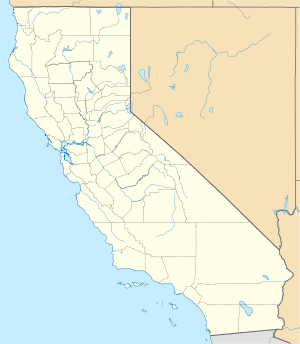Niantic (whaling vessel)
 |
|
| History | |
|---|---|
|
|
|
| Builder: | Connecticut |
| In service: | 1832 |
| Out of service: | 1849 |
| Renamed: | Niantic Hotel, 1849 |
| Fate: |
|
| General characteristics | |
| Type: | ship or barque |
| Tons burthen: | "could probably take eight or nine hundred tons in storage" |
| Length: | 119 ft 6 in (36.42 m) |
| Beam: | 29 ft (8.8 m) |
| Depth of hold: | 19 ft 6 in (5.94 m) |
| Propulsion: | Sail |
| Complement: | 28 |
|
Niantic (Storeship)
|
|
| Location | NW corner of Clay and Sansome Sts., San Francisco, California |
| Coordinates | 37°47′42.3″N 122°24′8″W / 37.795083°N 122.40222°WCoordinates: 37°47′42.3″N 122°24′8″W / 37.795083°N 122.40222°W |
| Area | 0.1 acres (0.040 ha) |
| Architect | Childs, Thomas |
| NRHP Reference # | 91000563 |
| Added to NRHP | 16 May 1991 |
Niantic was a whaleship that brought fortune-seekers to Yerba Buena (later renamed San Francisco) during the California Gold Rush of 1849. Run aground and converted into a storeship and hotel, she was a prominent landmark in the booming city for several years. The site of Niantic beside the Transamerica Pyramid is now a California Historical Landmark. Artifacts excavated in 1978 and the ship's log from her last voyage are on display in the San Francisco Maritime Museum.
1832—Niantic built in Connecticut. Originally intended for trade with China, she was later converted to a sperm whaler. Owners in 1840 appear to have been N. L. and G. Griswold of New York.
1840—Niantic, Captain Doty in command (Captain Robert Bennett Forbes acting), sailed with tea and silk from Port of Canton to an unstated destination (perhaps New York) via Anjer (Anyer), Indonesia, just missing a blockade by the British in Canton as part of the First Opium War. "Probably this was the last and most profitable voyage of Niantic as a merchant ship."
The China trade painting of Niantic at right shows her at the Whampoa anchorage near Canton. Although the date is unknown, 1840 seems likely.
1844—Niantic bought by C. T. Deering for whaling.
June 4, 1844—Niantic sailed from Sag Harbor, Captain Slate in command, for Pacific whaling cruise, including New Zealand whaling grounds.
...
Wikipedia

